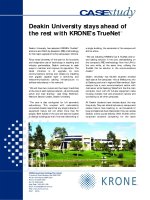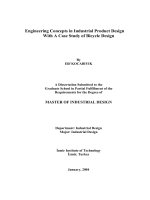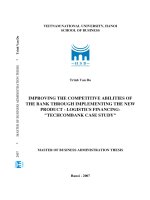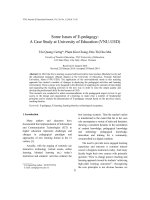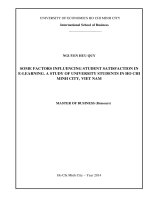Product-Testing-AD35-Laminar-Flow-Study-Auburn-University
Bạn đang xem bản rút gọn của tài liệu. Xem và tải ngay bản đầy đủ của tài liệu tại đây (227.87 KB, 12 trang )
An Experimental Investigation of Friction Reduction In Hydraulic Tubing With
an Advanced Oligomeric Silane Coating
Mike Brennison
Undergraduate
Aerospace Engineering Department
Auburn University
Auburn, Alabama
10 February 2003
Presented at the AIAA Southeastern Regional Student Conference
26-28 March, 2003
Kill Devil Hills, North Carolina
This paper has been reviewed and approved for presentation by Dr. Ron Barrett.
Abstract
This study investigated a new technique for increasing mass flow rates, reducing head loss and cutting
frictional losses in hydraulic tubing using an advanced silane surface coating technique. To determine the
amount of frictional reduction, two identical 21 ft (6.4m), 0.265" I.D. (6.7mm) tubes were used. One tube
was left untreated while the other was treated with an advanced silane coating. Hydraulic testing was
performed from Reynolds numbers of 6300 to 31600, flow rates from 0.6 gal/min (0.0379 l/s) to 3.0
gal/min (0.189 l/s) at head pressures from 3.1 psi (21.4 kPa) to 48.7 psi (336 kPa). Digital pressure gages
were mounted to dynamic dampeners at tube inlet and exit to measure head loss. Testing showed friction
factor reductions from 13.5% to 49.0% and mass flow rate increases from 18.1% to 46.6%. In addition to
examining the quantitative improvement in hydraulic flow properties, this paper also compares the
qualitative surface conditions inside the treated and untreated tubes.
1. Introduction
Industrial and Aerospace pipes and tubes have been treated with several different types of coatings in the
past ranging from paint to oil to reduce frictional losses. Currently, most hydraulic tubing remains
uncoated because surface coatings tend to flake off and become ineffective over time. In cases where
tubes are coated, many approaches have been taken in the past several years. Many polymers have been
used, derived mainly from polyurethane and polypropylene (Ref. 1). Other such attempts have been with
epoxies; this approach has been particularly popular for water works (Ref. 2).
One of the major advances in this field is the use of polyurethane. Polyurethane is primarily used for oil
pipes and gas lines. The polyurethane is generally a three-layer system. The polyurethane begins with a
layer of epoxy that is applied to the pipe itself. Over the epoxy, a polymeric jacket is applied. Finally on
top of the jacket, a layer of polyurethane is bonded(Ref. 3). Another popular approach has been with
polypropylene. From polypropylene, one can use either polyethylene or polyolefin. There are several
advantages with both of these polypropylene products. Polypropylene is very economical, resistant to
abrasion, and does a good job preventing corrosion to the tubing itself (Ref. 4).
The epoxies, such as 3M's 134 epoxy powder which cures at a thickness of 12 to 16 mils., are applied to
the tube surface as a powder and is then fused with the metal (Ref. 5). 3M has several similar powder
epoxies as part of their Scotchkote Line which has coated over 62,000 miles (100,000km) of pipelines
around the world since 1960 (Ref. 6). Some ideas to coat tubes have gone as far as to use coal tar based
epoxies. The reason for using coal tar is because of its hydrophobic properties (Ref. 7). Some companies
have even tried to use elastomers that can be applied in an airless spray and can be applied at virtually
any thickness. These elastomers are generally cured in the air at ambient temperatures (Ref. 8).
All of the techniques that have been used, including the ones mentioned above, suffer similar drawbacks
due to their organic polymeric backbones. A major problem with organic coatings is its tendency to
induce pitting in the metallic substrate. Another major drawback, perhaps the worst, is that all of these
organic materials have microscopic holes; these holes permit ionic migration that allows rust to occur on
the tube surface underneath the coating. Also, these organic coatings are generally thick, ranging from
10mil. (254µ m) estimated to 1 inch (25.4µ m), thereby robbing the tube of its flow capacity (Ref. 9).
In the past few years, a new inorganic coating, based on advanced silanes has been released into the
market. The silane forms an ionic bond with the surface of the tube; which is as strong as the bond
formed by an anodized coating. One property that makes the silane unique to other coatings is that it
cures at ambient temperatures. The silane spreads so thin that when it cures, it is only 6µ m thick. During
the curing process, it starts as a liquid pre-ceramic, and dries as a glass, yielding a very low friction
factor. The silane is inorganic, thin, and does not possess microscopic holes as do most organic coatings;
accordingly, the surface of the tube is protected from oxidization and pitting (Ref. 10).
The silane coating was developed to treat the Space Shuttle’s thermal tiles, and is now being used in
several different applications from treating air conditioning units to boat hulls (Ref. 11). In open water
experiments using the silane to treat boat hulls, it was noted that top speeds of a 23’ Seacraft Sport
Fishing Boat was increased 11% from 28 mph (45.1 km/h) to 31 mph (49.9 km/h), and accompanied by a
decrease of fuel consumption (Ref. 12). From these experiments, it was realized that the silane may be
able to reduce the friction in pipelines and tubing which could benefit Aerospace and several other
industries. Accordingly, greater mass flow rates could be achieved by smaller, lighter hydraulic tubes.
Given that typical wide body transport aircraft such as the DC-10 and a 747 have 6,000-7,000 lb’s (2,7003,200 kg) of hydraulic and fuel tubing on board, weight reductions in these subsystems could
significantly reduce operating empty weights (Ref. 13). Such weight reductions would in turn, translate to
millions of dollars saved each year in fuel costs.
2. General Description
The testing apparatus was built around the 21 ft (6.4 meter) lengths of tubing. The apparatus was made to
be a closed circuit to recycle the water used in the experiment. From the water reservoir, water was
pumped into the apparatus by a 1/3 horsepower Omega FPUGR100 Series Model #5k918C pump. The
water then flowed through a series of pipe fittings to a T-connector. The T-connector had a valve attached
at both outputs to control the amount of water that entered the test section; one outlet led to the test
section, the other led to a backflow that led back to the reservoir as seen in Figure 1.
Figure 1 Pump, Reservoir, Pressure Gage and Dynamic Dampener Set-Up
Just downstream at the valve, toward the test section was a T-connector connected to an Omega
DPG6000 digital pressure gage; to measure the inlet pressure in pounds per square inch to the nearest
tenth of a pound. In between the pressure gage and the T-connector is a dynamic dampening chamber to
reduce unsteady pressure fluctuations. Continuing past the pressure gage lay the test section of tubing.
Beyond the test section is another T-connector with a second Omega DPG6000 pressure gage and
dynamic dampening chamber; this is used to measure the exit head pressure of the tubing. Directly after
the second pressure gage is an Omega FTB4005 flow meter that measured how many gallons per minute
flowed through the tubing as seen in Figure 2.
Figure 2 Overall Test Set-Up
From the flow meter, another hose is connected back to the water reservoir. The sections of tubing that
are tested are both .265" I.D. (6.73mm) and both were similar in length at about 252". The exact lengths
were taken into consideration during calculations.
The experiment was performed by first using an untreated section of tubing that was 252.3" long. The
tubing was mounted to the test apparatus, then water was run through the system beginning with
maximum flow. Then time was allowed to let the pressure gages come to rest. Inlet and exit pressures
were then recorded. The next step was to measure how many gallons per minute flowed through the test
section. After recording the flow and both pressures, the back flow was opened until the inlet pressure
dropped between three and five pounds per square inch as seen in Figure 3.
Figure 3 Pressure Gage and Flow Meter Set-Up
The entire sequence was repeated several times, until the exit pressure was just above becoming opsig.
The untreated tubing was then removed and replaced with the tubing treated with Adsil AD 703 silane
coating. After the treated tubing was installed, the testing process was repeated.
3. Specimen Preparation
The experiment involved two different sections of .265" I.D. (6.73mm) diameter steel tubing; one to be
the untreated, another to be treated with the silane. To have the tubing in optimum conditions for testing,
they were cleaned out. The process of cleaning the tubing began with flushing the tubes with muriatic
acid. After the acid was drained, propanol was added to neutralize any leftover acid in the tubes. Finally
water was poured through the tubing to wash out what remained of the neutralized fluid as seen in Figure
4.
Figure 4. Test Tube Preparation with Muriatic Acid, Propanol & Silane
After the tubing was thoroughly flushed of contaminants, the next step was to thread the ends of the
tubing so that they could be connected to the testing apparatus. The placement of threads was done with a
size 1/8" die kit. The next step was to take the second tube and treat it with the silane. The silane
treatment was performed by plugging one end of the tube, and filling the tube with the silane. After
enough of the silane was poured into the tube, the other end is plugged and the entire unit was shaken and
rolled to ensure the entire tube had been coated. The silane was then drained from the tubing and was
allowed to air-cure. To assist the air cure, a heat gun was passed back and fourth along the tubing to
increase the temperature to 60°C, but to make sure none of the tubing becomes overheated causing
imperfections in the silane as seen in Figure 5.
Figure 5 Tube Heating during Oligomeric Silane Cure Process
4. Testing and Results
During the experiment, three numbers were recorded for each test; the inlet pressure, the exit pressure,
and the flow rate. The pressures were measured in pounds per square inch and the flow rate was
measured in gallons per minute. The testing of the tubing started by first observing and noting the tare
pressure on both of the pressure gages. The second step was to turn on the pump with the valves to the
test section and the backflow fully open to ensure that the pump and the instruments would not be
damaged. Once water from the reservoir was pumping through the system, the back flow valve was
slowly turned closed. The next step was to wait for enough water to run through the apparatus so that the
tubing came to a constant temperature from being cooled by the water. The end of the water temperature
fluctuation was judged by fluctuations in the inlet pressure gage; once the pressure stopped fluctuating for
more than a minute, it was deemed that the tubing had reached a final temperature.
The next step was to start taking readings from the instruments; starting with the maximum pressure that
could be achieved by the pump. Time was given for the pressure gage to find a constant pressure. Then
the inlet pressure, the exit pressure, and the flow rate were recorded. After these values were recorded,
the inlet pressure was decreased by three to five pounds per square inch. This process was repeated until a
minimum pressure was reached in the exit pressure gage. This exact process was for both the treated and
the untreated tubes. The first tube tested was the untreated tube while the treated tube came to a complete
cure. Two days were given to make sure that the treated tube had fully cured. The untreated tube was
removed from the apparatus and replaced with the treated tube. The same procedure for the untreated
tube will be followed for the treated tube as seen in Figure 6.
Figure 6 Datalogging during Testing
Figure 7 Flow Rate as a Function of Inlet -to-Exit Head Pressure Differential
Figure 8 Stanton Diagram of Friction Factor as a Function of Reynolds Number
From Figures 7 and 8, it can clearly be seen that the oligomeric silane coating produces a
significantly better flow quality with fewer frictional losses. After testing, both tubes were
sectioned to visually inspect the interior surfaces of the tubes. From Figure 9, it can be seen
that the surface quality of the uncoated tube is much rougher than the coated tube. Further
microscopic inspection revealed that the average surface grain size in the uncoated tube
was approximately 5 - 35 microns in diameter. Because the Adsil completely coated the
oxidized surface, forming a continuous ionic bond with the base metal, filleting in around
the rough surface elements, the surface protrusions averaged less than 10 microns above
the inner surface layer.
Figure 9 Untreated and
Treated Steel Tube Sections
5. Conclusions
It can be concluded that the oligomeric silane-coated steel tubes experienced friction factor reductions
from 13.5% to 49.0% with corresponding mass flow rate increases from 18.1% to 46.6% within Reynolds
numbers ranging from 6300 to 31,600. The results showed that the greatest decrease in the frictional
factor and the greatest increase in mass flow rate occurred at the lower Reynolds numbers and the least
decrease in friction factor and the lease increase in mass flow rate occurred at the higher Reynolds
numbers.
6.
Acknowledgments
The author of this paper would like to Dr. Ron Barrett for the use of his lab and for all of his
technical assistance and guidance for this project. The author would also like to thank Adsil L.L.C.
for the use of their advanced silane coatings that were used in the experiment.
7.
References
1. www.basell.com/pdfs/121.pdf 8 February, 2003.
2. www.coatingrobotics.com/pf1-2g.htm 8 February, 2003.
3. www.garneau-inc.com/coatings/coatings.html 8 February, 2003.
4. www.basell.com/pdfs/121.pdf 8 February, 2003.
5. www.coatingrobotics.com/pf1-2g.htm 8 February, 2003.
6. www.3m.com 8 February, 2003.
7. www.carboline.com/website/carbopdf.nsf/webview?OpenView&count=500 8 February, 2003.
8. www.polibrid.com 8 February, 2003.
9. Barrett, R.M., "The properties of organic coating materials." 9 February, 2003
10. Barrett, R.P., "Technical discussion concerning silane coating properties." 22 December, 2002.
11. Barrett, R.P., "Technical discussion concerning silane coatings on boat hulls". 22 December,
2002
12. Barrett, R.P., "Technical discussion concerning prior uses of silane coatings." 22 December,
2002
13. Roskam, J., "Airplane Design. Part 6: component aircraft weight information." University of
Kansas, Ottawa, 1985.
14. www.bayoupipe.com 8 February, 2003
15. www.madisonchemical.com 8 February, 2003.
